Many people overlook the importance of selecting the right drive belt for their John Deere 4020, yet it can greatly impact performance and longevity. You might be surprised to learn that not all belts are created equal; some can enhance power transfer and resist wear better than others. As you consider your options, you'll want to explore which belts stand out regarding durability and efficiency. Understanding these differences could make all the difference in keeping your equipment running smoothly. What are the best choices available for peak performance?
Quick Takeaways
- John Deere OEM Primary Drive Belt: Known for reliable construction, this belt connects engine to pulley efficiently, ensuring optimal performance for John Deere 4020.
- GX20072 Deck Belt: Made from high-quality Aramid and Neoprene, it offers excellent heat and abrasion resistance, making it suitable for heavy use.
- Drive Belt Replacement (GX20006): This 88.9-inch belt is compatible with various models, featuring high-strength material for enhanced durability under demanding conditions.
- Original Equipment Flat Belt – GX20072: With a robust construction that prevents stretching and rollover, this belt boasts a high customer rating for reliability.
- Material Quality Matters: Choosing belts made from Aramid cord and Neoprene ensures longevity and performance, crucial for maintaining the efficiency of the John Deere 4020.
John Deere GX22269 Transmission Drive Belt for Walk Behind Rotary Mowers
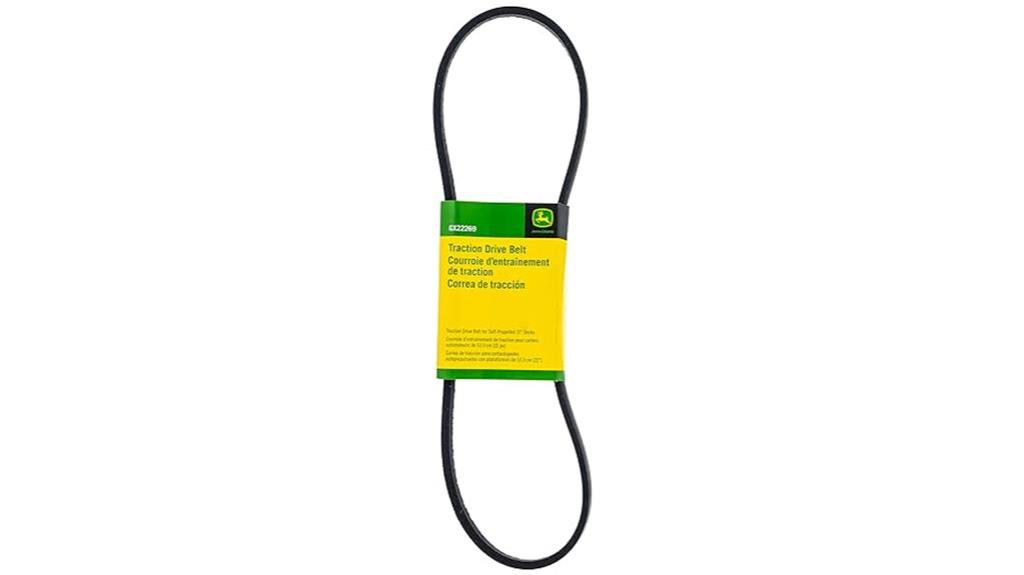
When it comes to maintaining the performance of your John Deere equipment, the John Deere GX22269 Transmission Drive Belt stands out as the ideal choice for owners of the JS20, JS30, and JS40 walk-behind rotary mowers.
I've found that this OEM part is crafted from strong material, which prevents stretching and rollover, ensuring smooth engagement and consistent power. Its design caters specifically to self-propelled mowers, so I can rely on its durability for long-term performance.
Many users, including myself, have praised its fit and how it has restored older models to like-new condition. With a reasonable price point, it's readily available for purchase, making it a top choice in my book for anyone looking to maintain their mower's efficiency.
Best For: Owners of John Deere JS20, JS30, and JS40 walk-behind rotary mowers looking for a reliable replacement drive belt.
Pros:
- High-quality OEM part that ensures optimal performance and durability.
- User satisfaction with fit and effectiveness in restoring older mower models.
- Affordable pricing for a reliable replacement component.
Cons:
- Limited compatibility only with specific John Deere models.
- Installation may require some mechanical knowledge or tools.
- Availability may vary based on location or stock levels.
John Deere OEM Primary Drive Belt
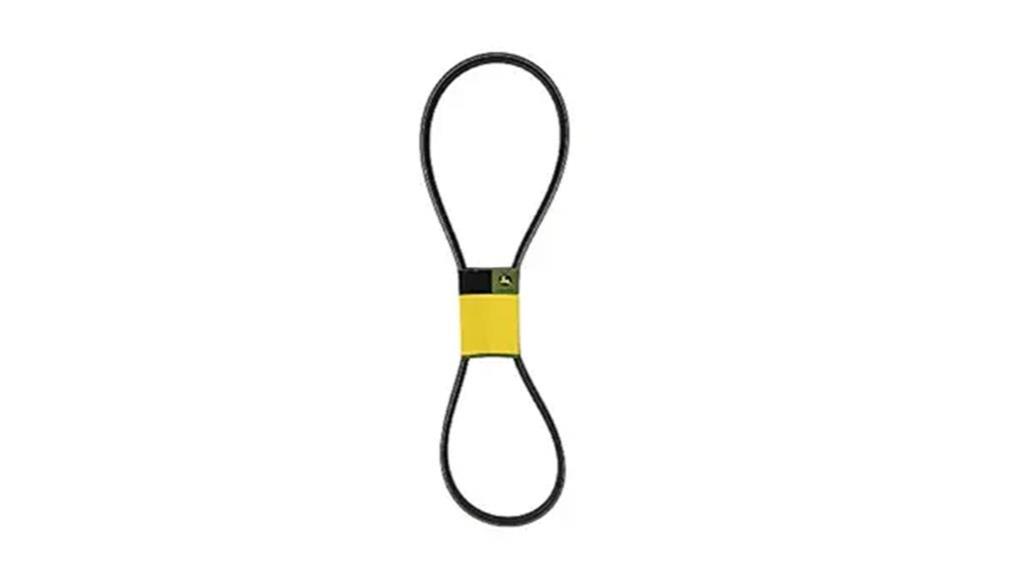
The John Deere OEM Primary Drive Belt is ideal for those who own compatible lawn tractors and need a reliable replacement part.
I've found that this belt, identified by part numbers M117608, M122818, M73478, and M84365, fits a wide range of models, including the 240, 245, 260, and many more. It effectively connects the engine to the top pulley on the deck, ensuring efficient power transfer.
I appreciate that it's designed for models with serial numbers up to 050000, making it a great choice for many users. Feedback from other customers highlights its reliability, though I've seen a few complaints about fit.
Overall, if you're looking for a dependable drive belt, this is a solid option.
Best For: Those who own compatible John Deere lawn tractors and need a reliable replacement drive belt.
Pros:
- High reliability: Customers report effective power transfer and overall satisfaction with performance.
- Wide compatibility: Fits numerous models, making it suitable for a range of lawn tractors.
- OEM quality: Genuine John Deere part ensures durability and longevity.
Cons:
- Fit issues: Some users have reported that the belt did not fit their specific model.
- Limited serial number range: Only applicable for models with serial numbers up to 050000.
- Higher cost: As an OEM part, it may be more expensive compared to non-branded alternatives.
John Deere Drive Belt Replacement (GX20006)
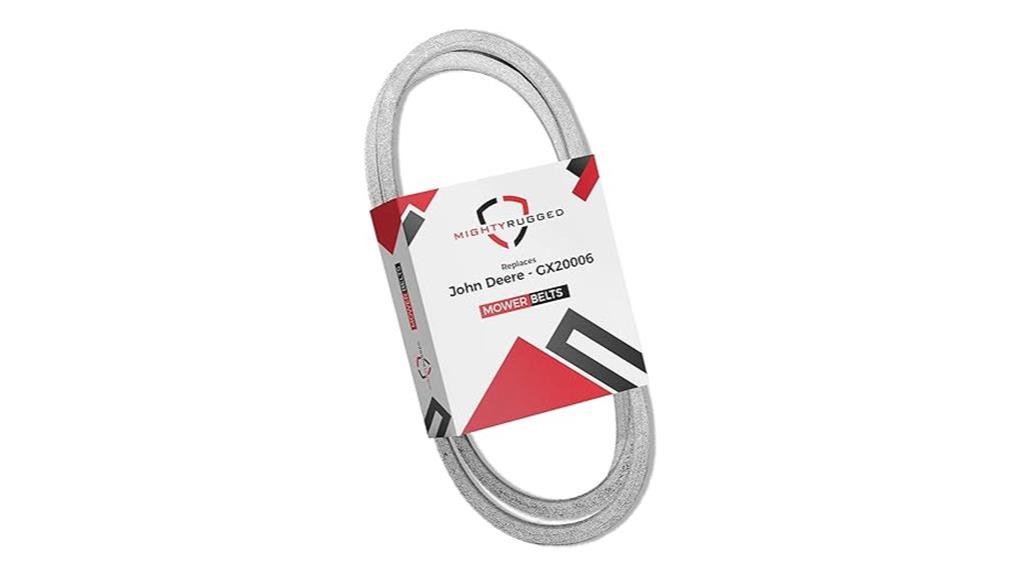
For anyone looking to enhance the performance of their John Deere mower, the GX20006 drive belt stands out as a reliable replacement option. This belt, measuring 88.9 inches in length and 0.5 inches in width, replaces OEM parts and is compatible with various John Deere models, including the 100, D, E, L, and LA series.
I appreciate the high-strength Aramid cord material, which promises reduced wear and tear. However, I've noticed mixed customer experiences regarding durability; some users reported breakage within hours while others enjoyed improved performance.
Installation is straightforward, making it user-friendly. Still, it seems that opting for an OEM belt might be wiser for guaranteed longevity, despite the higher cost.
Best For: Budget-conscious John Deere mower owners seeking a reliable replacement drive belt for enhanced performance.
Pros:
- Cost-effective alternative to OEM belts, providing savings for users.
- User-friendly installation process, making it accessible for DIY enthusiasts.
- Compatibility with a wide range of John Deere models, ensuring versatility.
Cons:
- Reports of variable durability, with some users experiencing breakage shortly after installation.
- Performance inconsistencies noted, with mixed feedback on effectiveness.
- Potentially less reliable than OEM options, leading to concerns over longevity.
GX20072 Deck Belt for John Deere 42 inch Lawn Mower
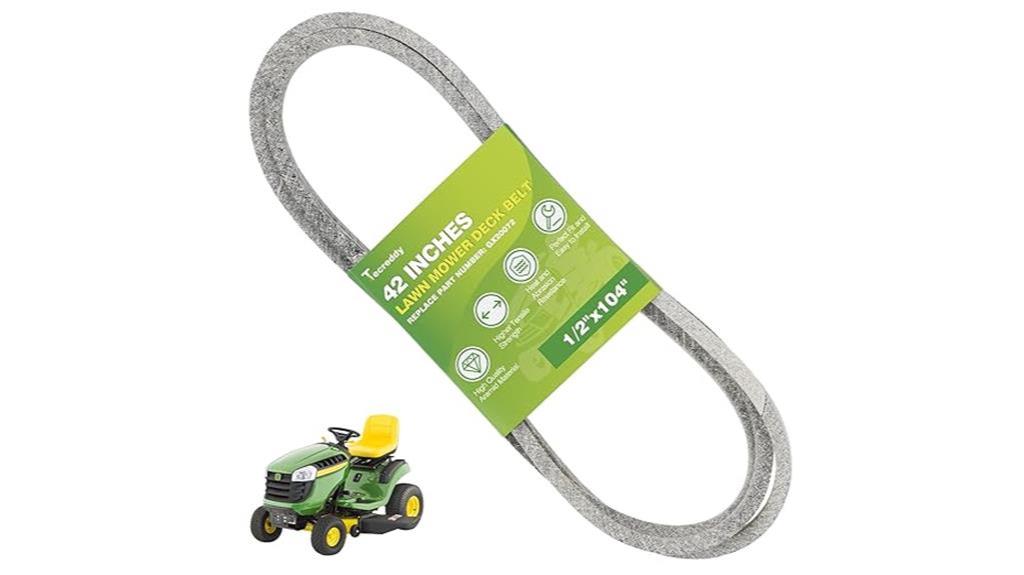
If you own a John Deere 42-inch lawn mower, the GX20072 Deck Belt is an excellent choice for maintaining peak performance.
This drive belt is compatible with several models, including the D100 and L110 series, making it versatile for various users. Made from high-quality Aramid and Neoprene, it's designed to resist heat and abrasion, ensuring durability during heavy-duty use.
I found its installation straightforward, and once fitted, it operated smoothly, extending the life of my mower.
While many users praise its performance and fit, I've noticed some feedback about potential fit issues on certain models.
Overall, if you're looking for a reliable deck belt, the GX20072 is definitely worth considering for your John Deere mower.
Best For: Those who own a John Deere 42-inch lawn mower and seek a durable and reliable replacement deck belt.
Pros:
- High-quality materials ensure heat and abrasion resistance for long-lasting performance.
- Easy installation allows for quick replacement, minimizing downtime for your mower.
- Compatible with a variety of models, providing versatility for different users.
Cons:
- Some users report fit issues with specific models, which may require additional adjustments.
- Feedback indicates potential longevity concerns, with varying performance across different units.
- Limited availability may pose challenges for immediate replacement needs.
John Deere Original Equipment Flat Belt – GX20072
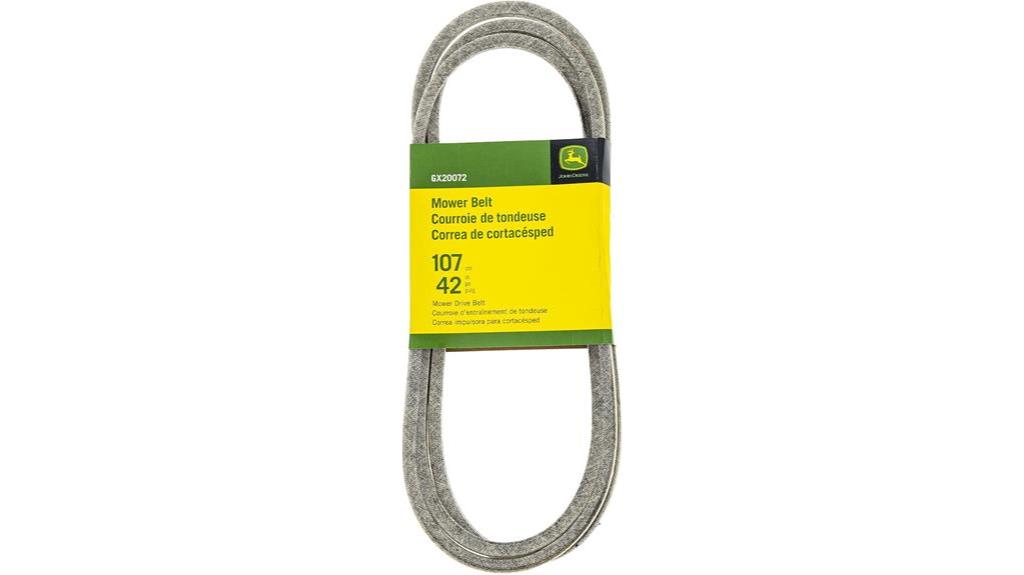
Looking for a reliable replacement for your John Deere mower? The John Deere Original Equipment Flat Belt – GX20072 is an excellent choice.
Measuring 15.98 x 10 x 0.98 inches and weighing just 9.6 ounces, this OEM belt is designed to fit various models including the D100 and LA series.
I've found that its robust construction prevents stretching and rollover, ensuring peak performance. With a customer rating of 4.6 stars from over 3,000 reviews, it's clear that many users appreciate its durability.
While some may hesitate at the price, I believe the reliability of this OEM belt is worth it. Plus, installation is straightforward, and I've noticed a significant improvement compared to non-OEM options.
Best For: Those seeking a durable and reliable replacement belt for their John Deere lawn mowers that enhances performance and fits various models.
Pros:
- High durability: Made from strong materials that prevent stretching and rollover.
- Easy installation: Users report straightforward setup, making it user-friendly for all skill levels.
- Positive customer feedback: High rating of 4.6 stars from over 3,000 reviews indicates satisfaction with performance.
Cons:
- Higher cost: OEM belts are typically more expensive than aftermarket options.
- Initial vibration: Some users experienced initial vibration, which may require a replacement.
- Limited lifespan: Typical lifespan of 1-2 years may necessitate frequent replacements.
Factors to Consider When Choosing Drive Belts for John Deere 4020
When choosing drive belts for your John Deere 4020, you need to take into account several key factors.
Compatibility with your model, material quality, and durability are essential for peak performance.
Additionally, think about installation ease and the specific length and width specifications to guarantee a proper fit.
Compatibility With Models
Choosing the right drive belt for your John Deere 4020 is vital for guaranteeing ideal performance and longevity of your equipment. To achieve this, you must verify that the selected belt meets your model's specific requirements and specifications.
Start by checking that the part number of the drive belt matches the OEM specifications; this helps avoid installation issues and guarantees a proper fit.
It's also wise to look into the compatibility of the drive belt with other models in the 20 series. Some parts may be interchangeable, which can broaden your options.
Review the manufacturer's documentation or guidelines to confirm the appropriate belt dimensions, like length and width, for the John Deere 4020. This step is vital as incorrect measurements can lead to performance problems.
Lastly, consider the type of drive system your 4020 uses—whether it's mechanical or hydrostatic. Different systems often require different belt configurations, so understanding your specific setup will guide you in selecting the right drive belt.
Material Quality and Durability
The quality of your drive belt's material directly affects its durability and performance, making it essential to select a belt made from high-strength materials. Options featuring Aramid cord and Neoprene are ideal, as they offer enhanced resistance to wear and tear.
When you're choosing a drive belt, prioritize those constructed from heat and abrasion-resistant materials. These belts tend to last longer and perform better in demanding conditions.
Many users prefer OEM (Original Equipment Manufacturer) belts due to their reliable construction. Aftermarket alternatives might seem tempting, but they often experience premature wear, which can lead to costly replacements.
Remember, the longevity of your drive belt also hinges on consistent tension and proper alignment. This helps prevent stretching and rollover, ensuring your belt works effectively over time.
Don't overlook customer feedback, either. Reviews frequently highlight the varying durability experiences across different brands and materials, underscoring the importance of quality.
Installation Ease
Selecting a drive belt isn't just about material quality; installation ease also plays a notable role in your decision-making process. The design of the drive belt can greatly influence how simple or complex the installation will be. Many belts come with straightforward setups that require only basic tools, making the process less intimidating.
It's vital to ascertain the drive belt is compatible with your John Deere 4020 model. A proper fit is essential for a smooth installation. Some manufacturers provide installation instructions, which can enhance your confidence and considerably reduce installation time, making these belts user-friendly.
Opting for OEM belts is generally recommended. They align perfectly with your tractor's original specifications, minimizing the need for adjustments and making installation easier.
You'll often find that belts explicitly designed for specific models require less effort to install than generic or aftermarket options, which mightn't fit as well.
Performance Reliability
When it comes to guaranteeing your John Deere 4020 operates smoothly, performance reliability in drive belts is vital. You want a drive belt that consistently transfers power and supports efficient operation, as downtime during significant tasks can be costly.
Opt for belts made from high-quality materials like Aramid and Neoprene; these enhance durability and longevity, minimizing premature wear under heavy-duty use.
Consider OEM (Original Equipment Manufacturer) belts, as they're designed to meet your equipment's specifications. This alignment boosts performance and lowers failure rates, giving you peace of mind.
Additionally, pay attention to user feedback regarding fit and installation ease. An improper fit can lead to vibrations and decreased reliability, so make sure you choose a belt that fits perfectly.
Regular maintenance and timely replacement also play a vital role in performance reliability. Many users report peak function when belts are replaced at recommended intervals.
Length and Width Specifications
Guaranteeing your John Deere 4020 maintains performance reliability goes hand in hand with understanding the significance of length and width specifications for drive belts.
When you're selecting a drive belt, it's vital to take into account the specific measurements required for ideal fit and functionality.
Drive belt lengths are typically measured in inches, so you'll want to ascertain that the belt you choose matches the manufacturer's specifications for your equipment. If you pick a belt that's too long or too short, you could face issues like slippage or premature wear, leading to inefficient power transfer.
Width specifications also play a significant role in performance. Common widths include 0.5 inches and 1/2 inches, and these fractions can affect compatibility with your machinery.
Always refer to the OEM specifications or a reliable reference chart to determine the correct dimensions. This guarantees that you're not only installing the right belt but also maximizing its effectiveness and lifespan.
OEM Vs. Aftermarket Options
Choosing the path between OEM and aftermarket drive belts for your John Deere 4020 can greatly impact your equipment's performance.
OEM belts, like those from John Deere, are known for their durability and reliability. They undergo rigorous testing and quality control, ensuring they meet the specific performance standards essential for peak operation. This means you can trust that an OEM belt will last longer and perform better under various conditions.
On the other hand, aftermarket drive belts can offer a cost-saving advantage, but their quality varies considerably. While some aftermarket options may serve you well, many customers report mixed experiences, including shorter lifespans and increased maintenance needs. If you rely heavily on your equipment, the potential trade-offs may outweigh the initial savings.
When deciding between OEM and aftermarket belts, consider your specific needs.
Evaluate the intensity of your usage and how crucial reliability is for your operations. If maintaining peak performance is crucial, opting for an OEM belt could be the best choice.
Ultimately, your decision should reflect your priorities regarding performance, longevity, and maintenance.
Price Considerations
Price plays a significant role in your decision-making process for drive belts on your John Deere 4020. When selecting belts, keep in mind that OEM parts usually come with a higher price tag due to their enhanced durability and performance compared to aftermarket options.
It's essential to budget for replacement belts, as the typical lifespan is only 1-2 years for standard belts, which can affect your long-term costs.
You should also be aware that price differences among belts often indicate varying quality levels. Opting for cheaper options might save you money upfront, but it could lead to higher maintenance expenses down the line.
If you need multiple belts for routine maintenance, look for discounts or bulk purchasing options, as these can offer substantial savings.
Warranty and Support
When it comes to drive belts for your John Deere 4020, warranty and support can make a notable difference in your overall satisfaction and peace of mind. Before making a purchase, check if the manufacturer offers a warranty. A solid warranty usually covers parts for a specific period, often between one to two years, which helps protect you against defects and premature failure.
It's vital to review the warranty conditions carefully, as they can vary considerably. Some warranties cover wear and tear, while others focus solely on manufacturing defects. Knowing what's included can save you from unexpected costs down the line.
In addition to warranty coverage, consider the support options available. Access to customer service and technical assistance is essential if you encounter installation or performance issues. Reliable support can guarantee you quickly resolve any problems, keeping your John Deere 4020 running smoothly.
Lastly, check the availability of replacement parts. Whether through local dealers or online platforms, having easy access to parts can greatly enhance your experience in maintaining your equipment effectively.
Prioritizing warranty and support will help you make an informed choice that meets your needs.
Common Questions
How Do I Know When to Replace My Drive Belt?
You'll know it's time to replace your drive belt when you notice signs of wear, like fraying or cracks.
If your machinery starts making unusual noises or if you experience slipping, that's another red flag.
Regularly check for any signs of excessive stretching or misalignment too.
If you're unsure, it's better to consult your owner's manual or a professional to guarantee peak performance and prevent further damage.
Can I Use Aftermarket Belts Instead of Oem?
Yes, you can use aftermarket belts instead of OEM ones, but you should be cautious.
Aftermarket belts might save you money, but their quality can vary greatly. Always check for compatibility with your specific equipment and read reviews to guarantee reliability.
If performance and durability are priorities for you, sticking with OEM belts may be the safer bet.
Ultimately, weigh the cost against the potential risks of using non-OEM parts.
What Is the Average Lifespan of a Drive Belt?
Imagine a well-worn road, smooth yet cracked, representing the journey of your drive belt.
On average, a drive belt lasts between 50,000 and 100,000 miles, depending on usage and maintenance. If you're diligent with inspections and replacements, you'll extend its life.
However, ignore those signs of wear, and you might find yourself stranded unexpectedly.
Regular checks can mean the difference between a smooth ride and a frustrating breakdown.
Are Drive Belts Specific to John Deere Models Only?
Drive belts aren't exclusively specific to John Deere models.
While many manufacturers design belts for their equipment, you can often find compatible options from third-party suppliers.
It's essential to check the specifications and dimensions to guarantee a proper fit.
When searching for a replacement, you'll want to take into account factors like durability and performance.
How Do I Properly Install a Drive Belt on My Tractor?
Did you know that improper drive belt installation can reduce your tractor's efficiency by up to 30%?
To install a drive belt on your tractor, first, confirm the engine's off and cool.
Remove the old belt by loosening tension and detaching it from the pulleys.
Next, position the new belt around the pulleys, confirming it's aligned correctly.
Finally, adjust the tension and secure everything back in place.
You're all set to get back to work!
Wrapping Up
In summary, choosing the right drive belt for your John Deere 4020 is essential for maintaining performance and durability. Notably, using OEM belts can extend the lifespan of your equipment by up to 30%. By opting for high-quality options like the John Deere OEM Primary Drive Belt or the GX20006, you guarantee reliable power transfer and peak operation. Don't compromise on quality—investing in the best will keep your tractor running smoothly for years to come!